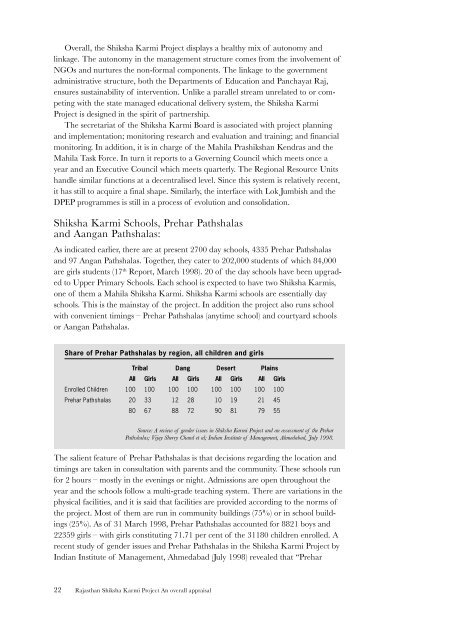Rajasthan Shiksha Karmi Project An overall appraisal
Rajasthan Shiksha Karmi Project An overall appraisal
Rajasthan Shiksha Karmi Project An overall appraisal
Create successful ePaper yourself
Turn your PDF publications into a flip-book with our unique Google optimized e-Paper software.
Overall, the <strong>Shiksha</strong> <strong>Karmi</strong> <strong>Project</strong> displays a healthy mix of autonomy andlinkage. The autonomy in the management structure comes from the involvement ofNGOs and nurtures the non-formal components. The linkage to the governmentadministrative structure, both the Departments of Education and Panchayat Raj,ensures sustainability of intervention. Unlike a parallel stream unrelated to or competingwith the state managed educational delivery system, the <strong>Shiksha</strong> <strong>Karmi</strong><strong>Project</strong> is designed in the spirit of partnership.The secretariat of the <strong>Shiksha</strong> <strong>Karmi</strong> Board is associated with project planningand implementation; monitoring research and evaluation and training; and financialmonitoring. In addition, it is in charge of the Mahila Prashikshan Kendras and theMahila Task Force. In turn it reports to a Governing Council which meets once ayear and an Executive Council which meets quarterly. The Regional Resource Unitshandle similar functions at a decentralised level. Since this system is relatively recent,it has still to acquire a final shape. Similarly, the interface with Lok Jumbish and theDPEP programmes is still in a process of evolution and consolidation.<strong>Shiksha</strong> <strong>Karmi</strong> Schools, Prehar Pathshalasand Aangan Pathshalas:As indicated earlier, there are at present 2700 day schools, 4335 Prehar Pathshalasand 97 <strong>An</strong>gan Pathshalas. Together, they cater to 202,000 students of which 84,000are girls students (17 th Report, March 1998). 20 of the day schools have been upgradedto Upper Primary Schools. Each school is expected to have two <strong>Shiksha</strong> <strong>Karmi</strong>s,one of them a Mahila <strong>Shiksha</strong> <strong>Karmi</strong>. <strong>Shiksha</strong> <strong>Karmi</strong> schools are essentially dayschools. This is the mainstay of the project. In addition the project also runs schoolwith convenient timings – Prehar Pathshalas (anytime school) and courtyard schoolsor Aangan Pathshalas.Share of Prehar Pathshalas by region, all children and girlsTribal Dang Desert PlainsAll Girls All Girls All Girls All GirlsEnrolled Children 100 100 100 100 100 100 100 100Prehar Pathshalas 20 33 12 28 10 19 21 4580 67 88 72 90 81 79 55Source: A review of gender issues in <strong>Shiksha</strong> <strong>Karmi</strong> <strong>Project</strong> and an assessment of the PreharPathshalas; Vijay Sherry Chand et al; Indian Institute of Management, Ahmedabad, July 1998.The salient feature of Prehar Pathshalas is that decisions regarding the location andtimings are taken in consultation with parents and the community. These schools runfor 2 hours – mostly in the evenings or night. Admissions are open throughout theyear and the schools follow a multi-grade teaching system. There are variations in thephysical facilities, and it is said that facilities are provided according to the norms ofthe project. Most of them are run in community buildings (75%) or in school buildings(25%). As of 31 March 1998, Prehar Pathshalas accounted for 8821 boys and22359 girls – with girls constituting 71.71 per cent of the 31180 children enrolled. Arecent study of gender issues and Prehar Pathshalas in the <strong>Shiksha</strong> <strong>Karmi</strong> <strong>Project</strong> byIndian Institute of Management, Ahmedabad (July 1998) revealed that “Prehar22 <strong>Rajasthan</strong> <strong>Shiksha</strong> <strong>Karmi</strong> <strong>Project</strong> <strong>An</strong> <strong>overall</strong> <strong>appraisal</strong>












